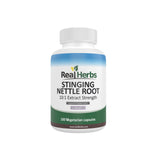Stinging Nettle Root in Traditional Medicine Practices
Introduction
Stinging nettle (Urtica dioica), a seemingly uninviting plant adorned with tiny, stinging hairs, has long held a significant place in traditional medicine practices across diverse cultures. Despite its sharp exterior, this botanical marvel has been revered for its potential health benefits for centuries. In this exploration, we delve into the roots of stinging nettle in traditional medicine, uncovering the historical tapestry woven by various civilizations and the modern scientific insights that validate its therapeutic potential.
Background of Stinging Nettle
Stinging nettle, with its serrated leaves and distinct stinging hairs, is a perennial herbaceous plant native to Europe, Asia, and North America. Its name, derived from the Old English word "netel," reflects its ability to cause a stinging sensation upon contact with the skin. Despite its intimidating nature, stinging nettle has been utilized for its medicinal properties since ancient times.
Historically, stinging nettle found its place in the traditional pharmacopeias of diverse cultures. Ancient Egyptians, Romans, and Native American tribes recognized its healing potential and incorporated it into their medicinal practices. The plant's application extended beyond medicine, with fibers from its stalks used for weaving and its leaves consumed as a nutrient-rich food source.
Historical Context
The historical use of stinging nettle in traditional medicine is a testament to the plant's resilience and adaptability. In ancient Greece, physicians like Hippocrates acknowledged its diuretic properties, recommending it for conditions related to fluid retention. Meanwhile, in Ayurvedic medicine, stinging nettle was celebrated for its ability to balance the doshas and promote overall well-being.
As trade routes expanded, stinging nettle's influence spread across continents. Native American herbalists harnessed its anti-inflammatory properties, utilizing it to address joint pain and arthritis. In medieval Europe, stinging nettle was a staple in monastic gardens, where monks cultivated it for its purported abilities to purify the blood and invigorate the body.
Active Compounds and Nutritional Profile
The potency of stinging nettle as a medicinal herb lies in its rich composition of bioactive compounds. Among these, lectins, lignans, and phenols contribute to the plant's anti-inflammatory and antioxidant properties. Stinging nettle also boasts a noteworthy nutritional profile, containing vitamins (A, C, and K), minerals (iron, magnesium, and calcium), and essential fatty acids.
Research indicates that the combination of these compounds may contribute to the plant's therapeutic effects. For instance, studies have suggested that the anti-inflammatory action of stinging nettle may be beneficial in managing conditions such as osteoarthritis and allergic rhinitis.
Traditional Medicinal Uses
Stinging nettle's versatility in traditional medicine is reflected in its application for various health conditions. Folk healers often turned to stinging nettle to alleviate ailments such as rheumatism, allergies, and skin disorders. The plant's purported diuretic properties were harnessed to address urinary issues and promote kidney health. Additionally, stinging nettle was frequently employed to fortify the body during times of convalescence.
In traditional Chinese medicine (TCM), stinging nettle was considered a cooling herb, used to clear heat and dampness from the body. TCM practitioners integrated it into formulas targeting conditions like joint pain and inflammatory skin disorders.
Modern Research and Scientific Findings
Contemporary scientific investigations have shed light on the potential health benefits of stinging nettle, aligning with its historical uses. Research studies have explored its anti-inflammatory effects, suggesting a role in managing conditions such as arthritis and allergic reactions. Moreover, stinging nettle's impact on prostate health has garnered attention, with some studies indicating potential benefits in managing benign prostatic hyperplasia (BPH).
While scientific exploration continues, it is essential to approach these findings with a nuanced perspective. The mechanisms behind stinging nettle's effects and its optimal dosage for therapeutic use warrant further investigation.
Cultural Significance
Stinging nettle's cultural significance extends beyond its medicinal properties:
-
Folklore and Traditions: In various cultures, stinging nettle has been woven into folklore and traditions. Some view it as a symbol of protection or as a harbinger of good fortune.
-
Ceremonial Practices: Certain indigenous communities incorporate stinging nettle into ceremonial practices, attributing spiritual significance to the plant.
-
Culinary Traditions: In regions where stinging nettle is foraged and consumed as food, it holds a place in local culinary traditions. Festivals celebrating the harvest of stinging nettle may be observed in some areas.
Conclusion
In conclusion, the stinging nettle root's journey through traditional medicine practices is a rich narrative of healing, resilience, and cultural significance. From ancient civilizations to contemporary research, its multifaceted nature continues to captivate the interest of those exploring alternative and complementary approaches to health. As we navigate the realms of tradition and science, the stinging nettle remains a testament to the enduring connection between nature and human well-being.












